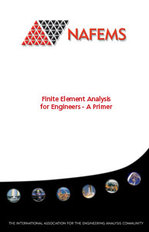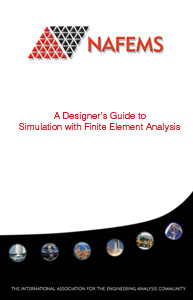The ‘Introduction to FEA’ collection offers three of NAFEMS’ most popular FEA publications, specially selected to provide an overall introduction to finite element analysis without over-complicated mathematics:
- Finite Element Analysis for Engineers - A Primer
- Knowledge Base - Don't Forget the Basics
- A Designer's Guide to Simulation with Finite Element Analysis

Details:
T.K. Hellen and A.A. Becker
December 2013
Hardback, 458 pages
Many of today's finite element systems are intended to be robust and friendly; and may be used by engineers and scientists who are unfamiliar with the finite element method, its virtues and its vices. Indeed,some finite element systems may be embedded in a CAD/CAE package and the user may be a production engineer, designer, or systems analyst who not only does not understand the characteristics of finite element systems, but may very well not even wish to know.
The problems of the novice have been identified and addressed in this primer. The aim is not to write just another finite element text book. There are scores of these, and many are daunting for the new reader since, not unnaturally, many go into algebraic detail of specific elements or they highlight areas of current research. The aim is also not to write a detailed instruction manual, since this cannot be done without referring to a specific system. Indeed, all commercial systems have their own introductory and users' manuals, together with more advanced programmers' manuals in some cases,and these are usually comprehensive. They do not, however, discuss the various vices or failings of the system, for obvious reasons.
This Primer will try to explain the basis of the Finite Element Method, stressing the essentially simple fundamental concepts without digressing into lengthy algebra or over-complicated mathematics. There will be no functional analysis in Hilbert spaces, and Lagrange multipliers will just be mentioned, even though they are used sparingly. Some algebra is inevitable;otherwise the text becomes a descriptive routine rather like explaining the fitting together of pieces of a jigsaw, and this can lead to all sorts of confusion. However, the algebra can be kept concise using matrix notation which is obligatory in discussing these methods. The Primer will strip some of the mysteries from the method and in particular will explain precisely what the method does exactly, and what it does approximately, and as a consequence which errors are important and which are not. Some errors are very useful sources of guidance.

Details:
M. Chillery
Published July 2010
Softback, 36 Pages
In October 2003, NAFEMS began to publish a series of articles in benchmark magazine, aimed at covering a number of basic FEA principals in a readable and useful format. This “knowledge base” series continued to run over the next seven years, based on the principal that it is always useful to reinforce basic concepts and theories, no matter how advanced the user of the technology has become.In that time, topics as diverse as mesh convergence, pressure vessel stresses, and fatigue have been covered by the author, Mark Chillery of Chalice Engineering. The aim has always been to outline the basic theories behind each topic, and give the reader a quick “one-page” refresher on the subject matter, without delving too deeply into the specifics of the area being covered.
After around 23 articles spanning many aspects of FEA, it was decided that the series itself had run its course, but that the material produced could provide great value to analysts by being put together in one reference manual, which could be used as a day-to-day guide to the basics of some of the engineering analysts most critical areas of work.
And so this ‘compilation’ has now been produced in order to bring these articles together in an accessible and user-friendly format, which we hope will prove invaluable as an initial reference into a multitude of topics.The articles themselves do not claim to be “definitive” guides to each topic, nor are they the only manner in which some of the analysis processes defined can be carried out – rather they are written from the perspective of an experienced analyst, working with the technology day in, day out.
This compilation also differs from many NAFEMS publications, in that the articles have not been extensively edited by the NAFEMS technical working groups. Each article itself could be developed into a publication many times the length of the original by going through this process, but the aim of the articles is not to provide an all-encompassing view of the topic being covered, rather, they should be treated as an introduction to the basics, to underpin basic concepts, and inspire further reading.We hope you find the book useful, and that it helps in some way towards reinforcing some technical knowledge that you use in your everyday work.As the byline says - “Don’t Forget the Basics...”

Details:
V. Adams
Published June 2008
Softback, 138 Pages
This book is an overview of methods and best-practices for mechanical design engineers and designers who are using or plan to utilize Finite Element Analysis (FEA) to validate design concepts or predict and correct product failure. The target readership is part-time users of CAD (Computer Aided Design) embedded analysis packages or those whose interface relies primarily on geometric references. This should not imply that the information presented herein is not important to users of other, more complete, analysis packages or that these users are by default any more capable of successfully simulating product performance. The assumption, right or wrong, is that with the greater investment required by purchasers of more complete tools, comes more investment in training and time to learn proper modelling practices. On the other hand, many users of design analysis tools receive little training beyond a basic software introduction, if even that. These design engineers or designers are typically reliant on whatever educational material is provided by their vendor and much of this is tool related. This book should pick up where that material left off.
In line with our mission, "To promote the safe and reliable use of finite element and related technology,” NAFEMS welcomes the growing ranks of “Design Analysts.” To aid them in making every simulation meaningful, this text is targeted at filling the gaps in knowledge left by basic software training. This book will attempt to summarize the collective body of knowledge as it pertains to proper modelling methods, analysis assumption construction, and results interpretation. Realistic expectations for the value of design analysis will be set that, while possibly tempering the blind enthusiasm some get when they are first exposed to FEA, should not discourage anyone who is serious about getting it right versus getting it done.
This is not a theoretical exploration of finite elements or their mathematical basis but a practical guide to using the technology effectively. The primary focus will be on CAD-embedded analysis tools or those that exclusively rely on geometric references for meshing and boundary condition input. However, much of the material will also be relevant to design engineers using more full-featured FEA systems. Where applicable, the limitations of the current offering of CAD-driven tools will be noted so that purchasers of more complete systems can justify their decision or investigate augmenting their more cumbersome tools with analysis products that integrate better with their CAD. Similarly, users of more limited systems can determine if they should be considering an upgrade once they understand the full potential of the technology. Based on the development of the technology over the last 5 years, it is reasonable to speculate that much of this discussion will still be applicable 5 years out. However, should a new paradigm or breakthrough technology, this author will be more than happy to offer a retraction!





